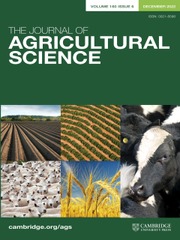No CrossRef data available.
Article contents
Identifying key environmental drivers of chickpea yield and water-use efficiency: a statistical modelling approach
Published online by Cambridge University Press: 10 September 2025
Abstract
Chickpea (Cicer arietinum L.) is a vital legume crop with significant global importance, yet its productivity is highly sensitive to environmental variability. This study employed advanced statistical modelling to identify key environmental drivers of chickpea yield and water-use efficiency (WUE). Field trial data from 29 experiments across 10 Australian locations were analysed, focusing on 19 climatic variables across four growth stages: sowing to flowering, flowering to podding, podding to maturity and the critical period around flowering. Using correlation analysis and Exclusive LASSO regression, the study quantified relationships between environmental factors, growth stages and chickpea performance metrics. Key findings identified soil evaporation and soil moisture supply-demand ratio during the sowing-to-flowering stage, along with frost during the critical period, as significant determinants of yield. Frost negatively impacted WUE across multiple growth stages, while mean photothermal quotient during early growth positively influenced transpiration-based WUE. Predictive models developed using daily climate data demonstrated strong performance (R2 > 0.68–0.72) for yield and WUE predictions. The study provides actionable insights for optimising chickpea production under varying environmental conditions, offering practical tools for farmers and agronomists to enhance crop management strategies, supporting sustainable and profitable chickpea farming in Australia and beyond.
Keywords
Information
- Type
- Crops and Soils Research Paper
- Information
- Copyright
- © The Author(s), 2025. Published by Cambridge University Press


